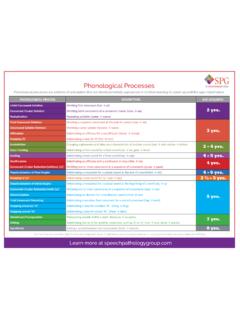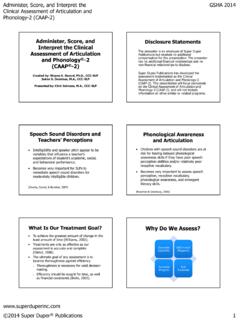Transcription of Guide to CM JK
1 13/23/2009 12:23:01 PM3/23/2009 12:23:01 PMCopyright 2008 LinguiSystems, may obtain additional copies of this Guide from in the 978-0-7606-0826-5 LinguiSystems, 4th AvenueEast Moline, IL 61244800-776-4332 FAX: 800-577-4555 Email: free downloads of these guides,go to 21/24/2011 2:29:15 PM1/24/2011 2:29:15 PMLS Guide to Communication Milestones 1 2008 LinguiSystems, of ContentsIntroduction .. 3 Feeding .. 4 Speech-Sound Acquisition Prelinguistic Speech Development.
2 5 Phoneme Development .. 6 Phonological Patterns .. 7 Speech Intelligibility Expectations .. 9 Pronouns .. 9 Morphology .. 10 Mean Length of Utterance .. 11 Pragmatics .. 12 Literacy .. 14 Phonological Awareness .. 16 Concepts .. 17 Vocabulary .. 18 Questions Answering Questions .. 18 Asking Questions .. 19 Listening .. 20 References, Websites, & Resources .. 22 Red Flags in Communication Development .. IBCG uide to 1 Guide to 19/29/2008 2:46:15 PM9/29/2008 2:46:15 PMLS Guide to Communication Milestones 2 2008 LinguiSystems, the AuthorsJanet R.
3 Lanza, , CCC-SLP, has worked as a speech-language pathologist in public schools, private practice, and a university clinic in Texas since 1976. She has been on the faculty of the Department of Communication Sciences and Disorders at Texas Christian University in Fort Worth, Texas, since 1989. At the TCU Miller Speech and Hearing Clinic, Janet is an instructor and clinical supervisor for classroom settings of preschool children with a variety of communication disorders. Lynn K. Flahive, , CCC-SLP, has over 25 years experience as a speech-language pathologist.
4 She worked in private and public schools in Wisconsin, Ohio, Illinois, and Texas for 12 years before joining the Department of Communication Sciences and Disorders at Texas Christian University in Fort Worth, Texas. Lynn has special interests in working with early childhood and early elementary-aged children with phonological and/or language delays. She is a Board Recognized Specialist in Child Language. Lynn is past President of the Texas Speech-Language-Hearing Association and past Executive Director of the National Student Speech Language Hearing and Lynn have co-authored numerous products for LinguiSystems.
5 They also present workshops nationally and in Canada on the topics of practical and motivational speech and language therapy for young to 2 Guide to 29/29/2008 2:47:02 PM9/29/2008 2:47:02 PMLS Guide to Communication Milestones 3 2008 LinguiSystems, should I expect my child to say two-word phrases, produce consonant clusters, or follow two-step directions? Does this client have the speech and language skills that are expected at his age? These are questions often asked of us as speech-language pathologists (SLPs) or that we ask ourselves as we work with children with communication to researchers and clinicians who have provided us with invaluable information over many years, we know that typical speech and language development follows a predictable progression.
6 SLPs must familiarize themselves with the steps in this progression to provide the most effective therapy for clients and to give honest, research-based information to their families. If you are like us, you learned much of this information in college and, given some time to search, could locate it if you needed to. But time is scarce in the life of an SLP. This booklet provides this important information at your fingertips. We found many different sources for communication milestones while conducting research to create this Guide .
7 Most sources agree with each other; some vary a bit. We drew from numerous reliable sources to provide a snapshot of milestones for the major areas of childhood speech and language. As in all listings of milestones, the information represents an average age at which most monolingual, English-speaking children will acquire a skill. If a child has not mastered a certain skill by the suggested age, that does not indicate a disorder. However, if most of the items in an age range have not been achieved, parents and professionals who work with the child should consider further investigation in that Guide to Communication Milestones contains developmental milestones for the following areas:We learned a great deal and were reminded of so much helpful information while developing this resource.
8 This process also served as a nice validation that we really are doing things in the right order! We look forward to having this booklet on our shelves to use as a handy reference when talking to parents and co-workers and when making clinical decisions. We hope you will too! Janet and LynnIntroduction Feeding Speech-Sound Acquisition - Prelinguistic Speech Development - Phoneme Development - Phonological Patterns - Speech Intelligibility Expectations Pronouns Morphology Mean Length of Utterance Pragmatics Literacy Phonological Awareness Concepts Vocabulary Questions - Answering Questions - Asking Questions ListeningGuide to 3 Guide to 39/29/2008 2:47:02 PM9/29/2008 2.
9 47:02 PMLS Guide to Communication Milestones 4 2008 LinguiSystems, American Speech-Language-Hearing Association states that speech-language pathologists play a primary role in the evaluation and treatment of infants, children, and adults with swallowing and feeding disorders (ASHA, 2002). SLPs are knowledgeable about normal and abnormal anatomy and physiology with respect to respiration, swallowing, and speech. Thus, it is appropriate for SLPs to play a role in 4 months Sucks fingers when near mouth Places hands on bottle during feeding Recognizes a nipple or bottle Pats a bottle with one or both hands5 6months Holds a bottle independently with one or both hands Mouths and gums solid foods Opens mouth when a spoon is presented6 9 months Feeds self crackers Drinks from a cup held by an adult some loss of liquid Reaches for a spoon when presented / bangs a spoon Prefers for a parent
10 To feed9 12months Holds a soft cookie in mouth (9 months) and bites through it (12 months) Imitates stirring with a spoon Eats lumpy, mashed food Chews using rotary jaw action (emerging)12 18 months Grasps a spoon with a full hand Brings a full spoon to mouth, turning spoon over en route Begins to drink through a straw Holds a cup with two hands Drinks with four or five consecutive swallows18 24 months Gives up the bottle Scoops food with a spoon and brings to mouth with spillage Drinks from a cup with limited spillage Swallows with lip closure Self-feeds frequently Chews a broad range of food Has precise up / down tongue movement24 36 months Bites through a variety of food thicknesses Brings a spoon / fork to mouth, palm up.





